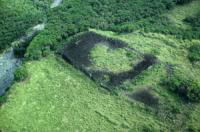Radiocarbon testing challenges understanding of ancient Hawaiian architecture, social complexity

An aerial view of a large war temple (Loaloa) on Maui. Credit: Courtesy Michael Kolb and Northern Illinois University.
The development of monumental architecture and social complexity on the Hawaiian island of Maui occurred over a span of at least 500 years, according to the most detailed study to date on the antiquity of the island's extensive temple system. The findings, in the August issue of Current Anthropology, challenge previous conceptions of ancient Hawaiian civilization by identifying cycles of temple construction that coincide with politically charged periods of warfare and island consolidation.
“Because the islands are relatively isolated from the rest of the world, the development of monumental architecture and complex society in Hawaii is of keen interest to archaeologists,” writes Michael Kolb (Northern Illinois University), who spent more than a decade locating and excavating temple sites. “In many ways, Maui represents an excellent test case for state development. Its monumental architecture is directly linked to economic, political, and ritual development, not unlike the most famous early civilizations, such as the Maya or ancient Eqyptians.”
Kolb conducted radiocarbon-dating analyses on samples from forty ruins on the island of Maui, including several newly discovered temples. The radiocarbon dates indicate the earliest temples were built in the 13th century, with construction continuing into the early 19th century. Prior research had indicated that Maui's temples, known as heiau, were built within a span of decades near the turn of the 17th century.
Kolb's study also identifies an important shift in temple construction from open-air temples used for ancestral worship to enclosed, more elaborate temples used for sacrificial offerings to war gods. Large temples often covered more area than a football field and stood 40 feet in height.
“The Hawaiian civilization lacked ceramics, which is typically why radiocarbon dating is relied upon by scientists,” says Kolb. “Before a temple was built, the land would be set ablaze to clear it from vegetation, leaving behind charcoal remains. We also were able to gather samples for dating from the sites of ancient ovens and bonfires.”
The ancient people of Maui stacked lava rocks to form the foundation of the platform temples, often built on the faces of cliffs or other high points on the island. The more elaborate, terraced temples were adorned with altars, oracle towers, offering pits, and god or ancestral images carved from wood or stone.
“Oftentimes, in a show of economic might, a conquering chief would remodel, build additions to, and rededicate a rival's temples,” explains Kolb. “Many of the early structures were modified or new ones were built with enclosures on top. Access was limited to reward loyal constituents, and sacrificial worship became more of a focus.”
Media Contact
All latest news from the category: Architecture and Construction
Newest articles

Silicon Carbide Innovation Alliance to drive industrial-scale semiconductor work
Known for its ability to withstand extreme environments and high voltages, silicon carbide (SiC) is a semiconducting material made up of silicon and carbon atoms arranged into crystals that is…

New SPECT/CT technique shows impressive biomarker identification
…offers increased access for prostate cancer patients. A novel SPECT/CT acquisition method can accurately detect radiopharmaceutical biodistribution in a convenient manner for prostate cancer patients, opening the door for more…

How 3D printers can give robots a soft touch
Soft skin coverings and touch sensors have emerged as a promising feature for robots that are both safer and more intuitive for human interaction, but they are expensive and difficult…





















